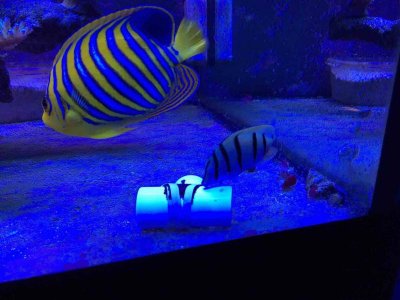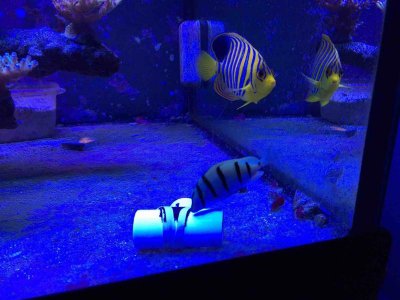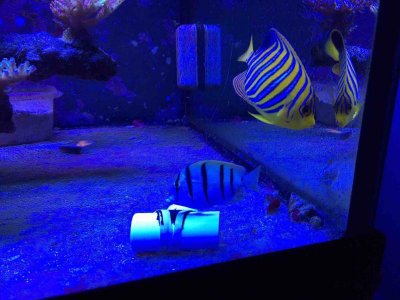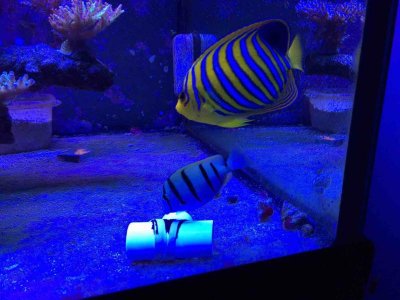ThRoewer
New member
I have a 3 inch Philippine regal in a 25 gallon (for now) and he does fine. But that tank has a lot of rocks in it.
The other Philippine is in a 40B, also lots of rocks and he does fine too.
Since these two were of equal size when I got them the dominant started attacking the submissive while I had them together in the 42 CAD light that now houses my 3 yellow bellies (as QT). My goal was to get one (the dominant) to grow more than the other (the submissive) before pairing them up again.
Larger specimen need of course larger tanks. A 100 gallon is probably the lower limit for 6"+ pairs.
For fully grown adult pairs (foot longs) I would want a tank of no less than 500 gallon with plenty of rock structures with lots of caves, crevices and canyons.
The ideal tank size is probably 1000 gallon or more, but it doesn't mean that they can't get along in much smaller tanks for years.
It seems that the growth of regal angel is controlled by their environment and social pressure. So a smaller tank may stun their growth while a large and especially tall tank may promote (or be required for) their growth. This would kind of coincide with the low growth rates many observe with their regals in 100 to 300 gallon tanks.
As for the eating issue:
I found that regals who spend the least time in barren holding tanks do the best. Also small individuals around 3" seem to do better and are less fickle than larger specimen. They seem less specialized in their feeding habits.
The statement that Red Sea regals are doing better than all others is a pure myth IMO. All they have going for them are the slightly more vibrant colors.
I had no issues with Philippine or other Pacific regals either.
So far I actually found the Pacific bluebellies to show more personality.
I can confirm their individuality. Some are laid back and easy going while others are outright divas that rather go on a hunger strike then change their ways easily. The larger they are the more individuality they show.
Having two (or more) together may also help to entice them to eat as long as at least one of them eats.
The other Philippine is in a 40B, also lots of rocks and he does fine too.
Since these two were of equal size when I got them the dominant started attacking the submissive while I had them together in the 42 CAD light that now houses my 3 yellow bellies (as QT). My goal was to get one (the dominant) to grow more than the other (the submissive) before pairing them up again.
Larger specimen need of course larger tanks. A 100 gallon is probably the lower limit for 6"+ pairs.
For fully grown adult pairs (foot longs) I would want a tank of no less than 500 gallon with plenty of rock structures with lots of caves, crevices and canyons.
The ideal tank size is probably 1000 gallon or more, but it doesn't mean that they can't get along in much smaller tanks for years.
It seems that the growth of regal angel is controlled by their environment and social pressure. So a smaller tank may stun their growth while a large and especially tall tank may promote (or be required for) their growth. This would kind of coincide with the low growth rates many observe with their regals in 100 to 300 gallon tanks.
As for the eating issue:
I found that regals who spend the least time in barren holding tanks do the best. Also small individuals around 3" seem to do better and are less fickle than larger specimen. They seem less specialized in their feeding habits.
The statement that Red Sea regals are doing better than all others is a pure myth IMO. All they have going for them are the slightly more vibrant colors.
I had no issues with Philippine or other Pacific regals either.
So far I actually found the Pacific bluebellies to show more personality.
My DD regal was eating in short order. These fish are all individuals and react as such regardless of who sells them. The one thing I can count on when buying from DD, is that the only disease that came from them is ich.
I can confirm their individuality. Some are laid back and easy going while others are outright divas that rather go on a hunger strike then change their ways easily. The larger they are the more individuality they show.
Having two (or more) together may also help to entice them to eat as long as at least one of them eats.




